
Text © Prof. Pietro Pavone

English translation by Mario Beltramini
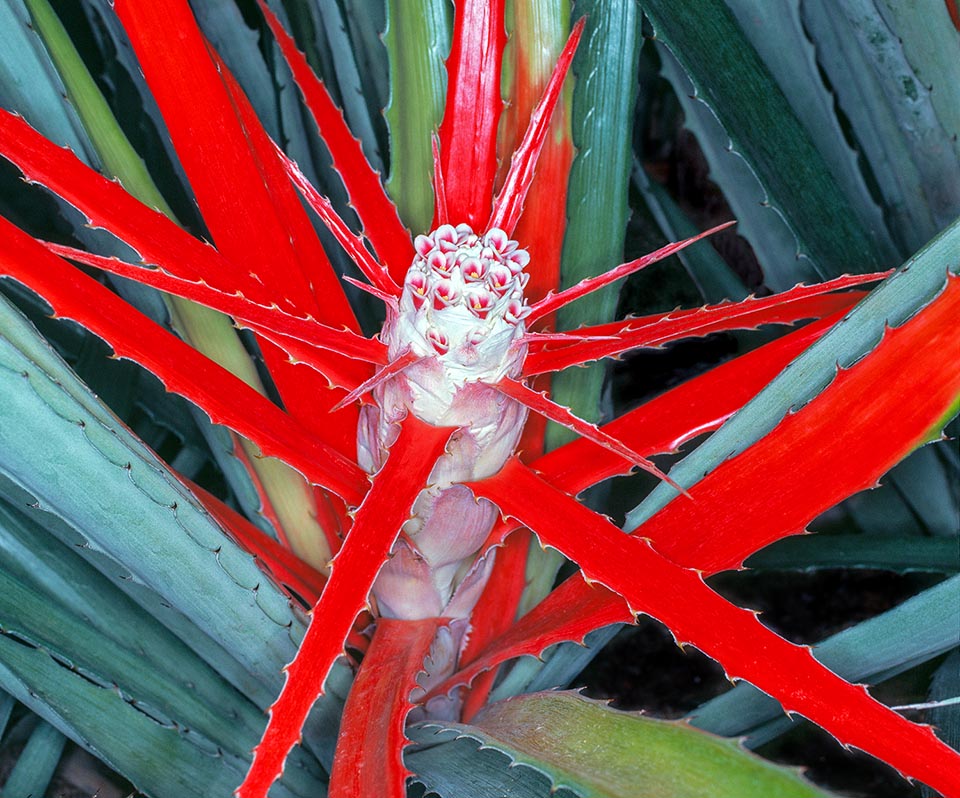
The Bromeliaceae family gets the name from the genus Bromelia, rich in 70 species. Here a showy Bromelia balansae in flower, that has edible fruits with medicinal virtues © Giuseppe Mazza
The name of the family Bromeliaceae Juss., (1789), now included in the order Poales, comes from the genus Bromelia that the French botanist Charles Plumier (1646-1704), a Minims friar, dedicated to the Swedish physician and naturalist Olaf Brumer (1699-1705).
In the past, the family was divided into three subfamilies Bromelioideae, Pitcairnioideae and Tillandsioideae, but molecular studies made evident that the subfamily Pitcairnioideae did not form a natural group, whilst the other two subfamilies were monophyletic because they included all the species coming from their own common ancestor.
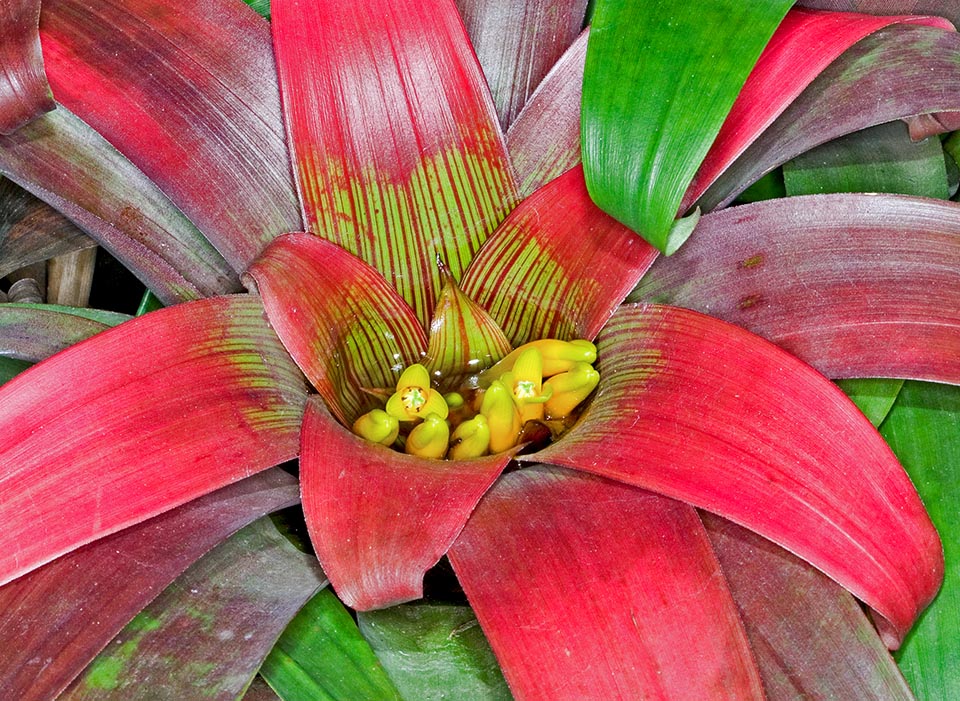
Close-up of a Guzmania sanguinosa with the typical central well where the rainwater gathers. It has been calculated that in one hectare of rainforest, these “cups” may contain tens of thousands of litres. Important water source during the drought periods, it stores nutrients for the plant and allows the life of many species © G. Mazza
Therefore, it has been decided to revise the distribution of the subfamily Pitcairnioideae subdividing it in monophyletic groups, based on the molecular data integrated by the morphological characters of the flowers, the fruits and of the seeds.
So, the species have been diversified among the new subfamilies Brocchinioideae, Hechtioideae, Lindmanioideae, Navioideae, Pitcairnioideae (sensu stricto), and Puyoideae, to which add the preexisting Bromelioideae and Tillandsioideae. Consequently, in the light of these new alterations, not final however, the Bromeliaceae include now 8 subfamilies, 98 genera and 3.659 species.
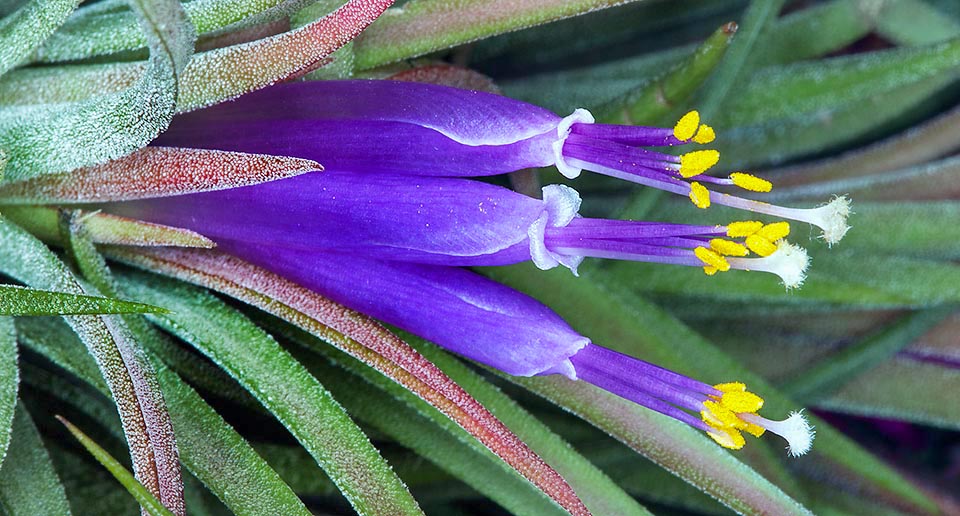
Blooming Tillandsia ionantha. We note the trichomes on the leaves: tiny hairs absorbing quickly the rainwater, like many small roots © Giuseppe Mazza
The subfamily Brocchinioideae counts the only genus Brocchinia, with 20 species; the subfamily Bromelioideae has 995 species, and includes 40 genera, and the richest in species are: Aechmea (244 species), Cryptanthus (60 species), Neoregelia (123 species) and Orthophytum (67 species); the subfamily Hechtioideae has 84 species with the only genus Hechtia; the subfamily Lindmanioideae has two genera: Connellia (6 species) and Lindmania (39 species): the subfamily Navioideae includes 111 species where the richest genus is Navia (94 species): the subfamily Pitcairnioideae includes 673 species grouped in 5 genera, the richest being Pitcairnia (410 species); the subfamily Puyoideae having only the genus Puya with 227 species and the subfamily Tillandsioideae with 1504 species and 29 genera, the richest in species are Racinaea (82 species), Tillandsia (755 species), and Vriesea (231 species).
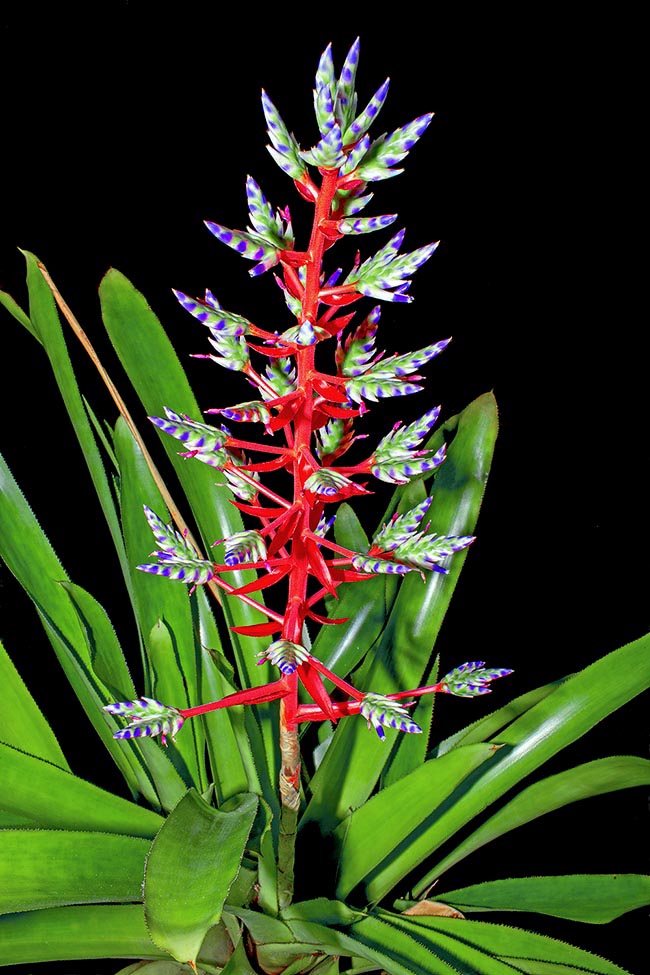
Aechmea dichlamydea with the characteristic central inflorescence that may reach in this species the 50 cm © Giuseppe Mazza
The Bromeliaceae are plants native to the tropical and subtropical regions in the New World with the only exception of the African species Pitcairnia feliciana (A. Chev.) Harms & Mildbr, found on the monadnocks of siliceous sandstones in the highlands of Fouta Djallon in Central Guinea (West Africa).
In American the distribution area extends from Chile to Argentina, Brazil, through Central America and the Caribbean, to reach its northern limit in Virginia, in the south-eastern USA.
They are herbaceous monocotyledon plants, at times very big, like Puya raimondii Harms, terricolous, lithophytic (growing on rocks), or epiphytic (growing on trees), and usually having perennial leaves, alternated, simple, rigid, at times very thorny on the edges and usually arranged in rosette that, due to the enlargement of their bases, form a sort of a “cup”, where the rain water collects.
The arrangement of the leaves in rosette, besides the advantage of accumulating water, allows also the development of communities of insects, arachnids, frogs, small snakes, etc., whose organic waste can be utilized by the plant itself.
This sort of strategy for getting the water and the nutrients is proper to those species that live in environments where the annual average rainfall does exceed the 1.000 mm.
It has been calculated that in one hectare of pluvial forest, these “cups”may contain tens of thousands of litres of rain water and catch several hundreds of kilogrammes of humus up in the cyme and furnish food to many species, including primates and birds.
Another strategy is given by the succulent leaves and by the presence of peltate foliar hais (trichomes), specialized in rapid water intaking, in particular in the epiphytic species (Tillandsia L. and Vriesea Lindl.), that absorb water through the leaves and through the roots that, conversely, serve only as support. The trichomes are found also in the species that live in arid environments and have a high solar radiation, giving protection.
From the foliar rosette appear the inflorescences that only rarely can form also in the axils of the leaves. The inflorescences are ears or clusters, usually bearing regular, pentacyclic and trimerous flowers. This means that they have two perianthial verticils, of three elements differentiated in calyx , usually green, and corolla formed by petals, free or connate at the base, shaped like a tube, very showy.
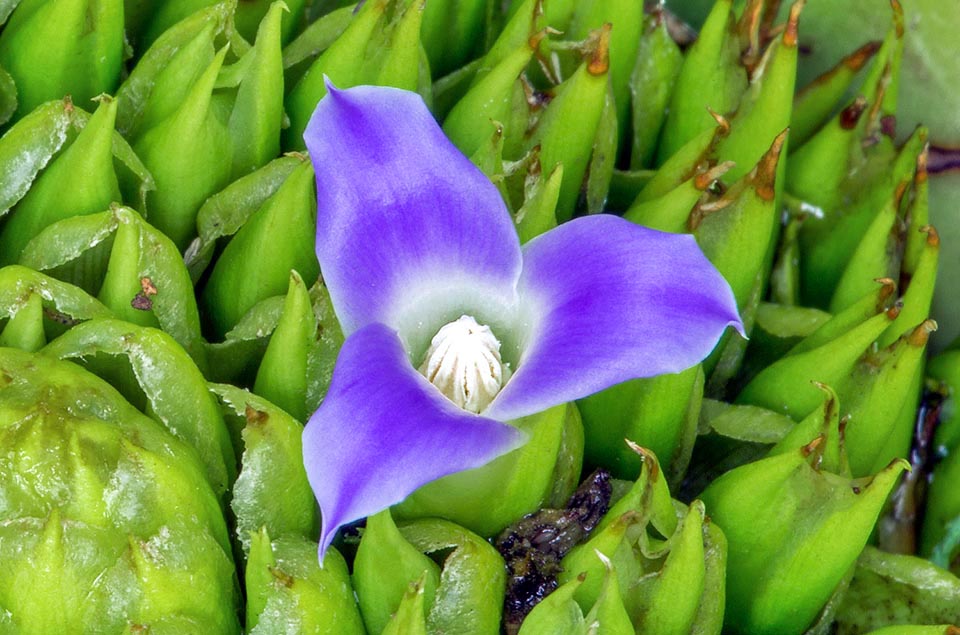
Conversely the Neoregelia cruenta floral scape is truly short, with corollas at the cup level. The Bromeliaceae shiny flowers are trimerous, that is formed by three parts © Giuseppe Mazza
The androecium is formed by two cycles of stamens with free or connate filaments, at times adnate in the corolla, equal or unequal and anthers with longitudinal dehiscence.
The gynoecium is formed by three carpels fused in a trilocular ovary with axial placentation. In the family, the position of the ovary varies: we have hypogynous flowers (superior ovary) in the Tillandsioideae and epigynous flowers (inferior ovary) in the Bromelioideae.
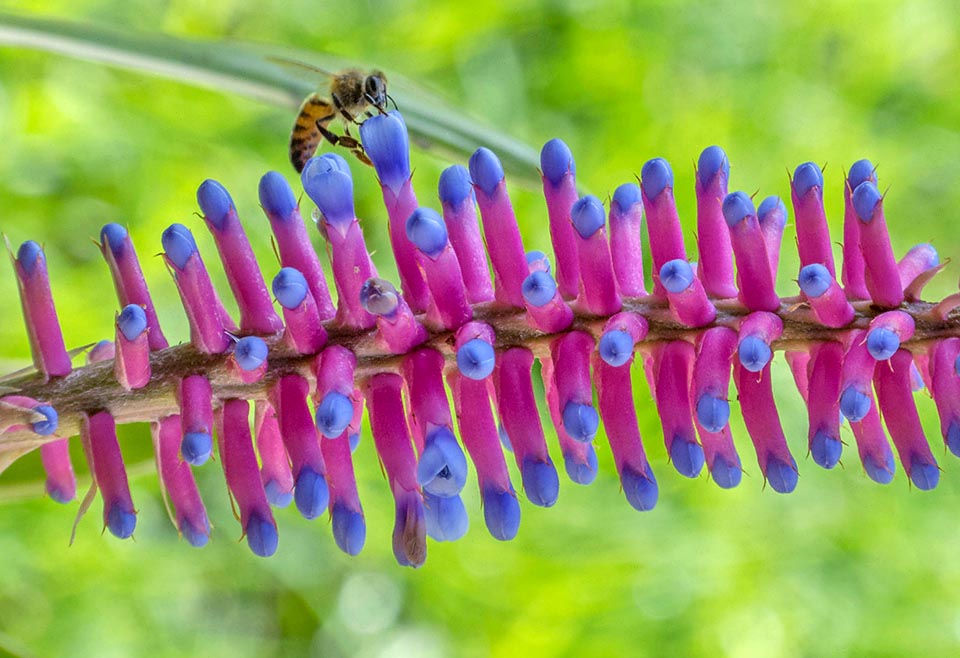
Aechmea gamosepala, called in Brazil “Matchstick plant” for the odd look of the flowers, however showing at the apex the typical trimerous structure. Here pollination is entrusted to a bee. The entomophily has been ancestral in Bromeliaceae, but then have trusted in bats and birds attracting them with showy colours © Priscilla Burcher
The pollinators can be insects, hummingbirds and bats. The pollination done by insects, proper to all species Brocchinia and Lindmania, and most of the species of Brewcaria, Catopsis, Cottendorfia, Navia and Fosterella, is thought to be ancestral whilst the pollination due by birds is secondary.
Most of the high altitude species (genera Abromeitiella and Deuterocohnia), and of the dry environments of the high Andes are pollinated by hummingbirds.
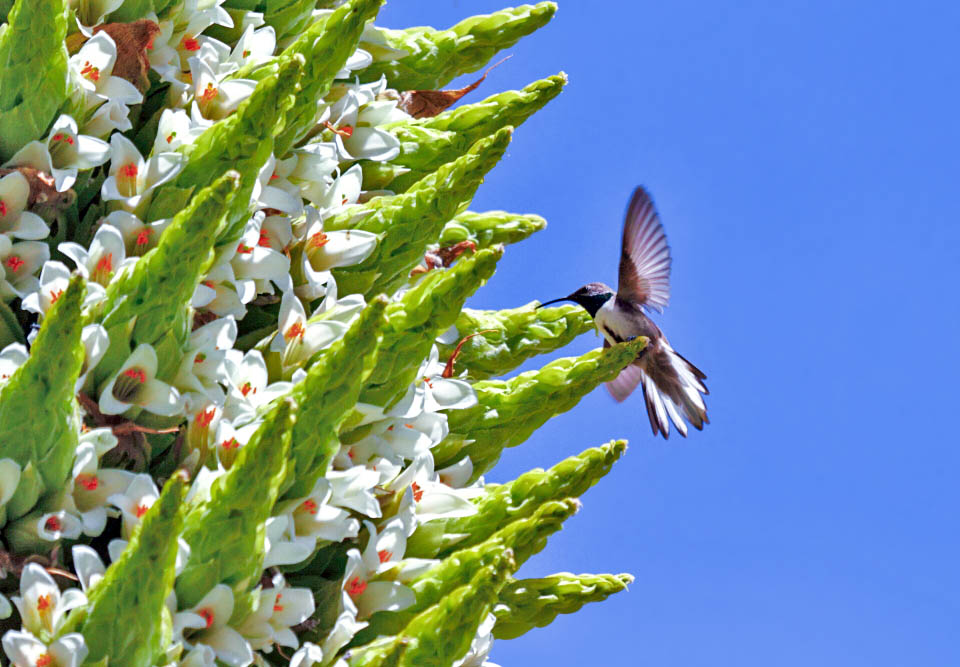
In Bolivia the Puya raimondi nectar attracts here an Oreotrochilus estela, hummingbird endemic to Andes © James Brunker
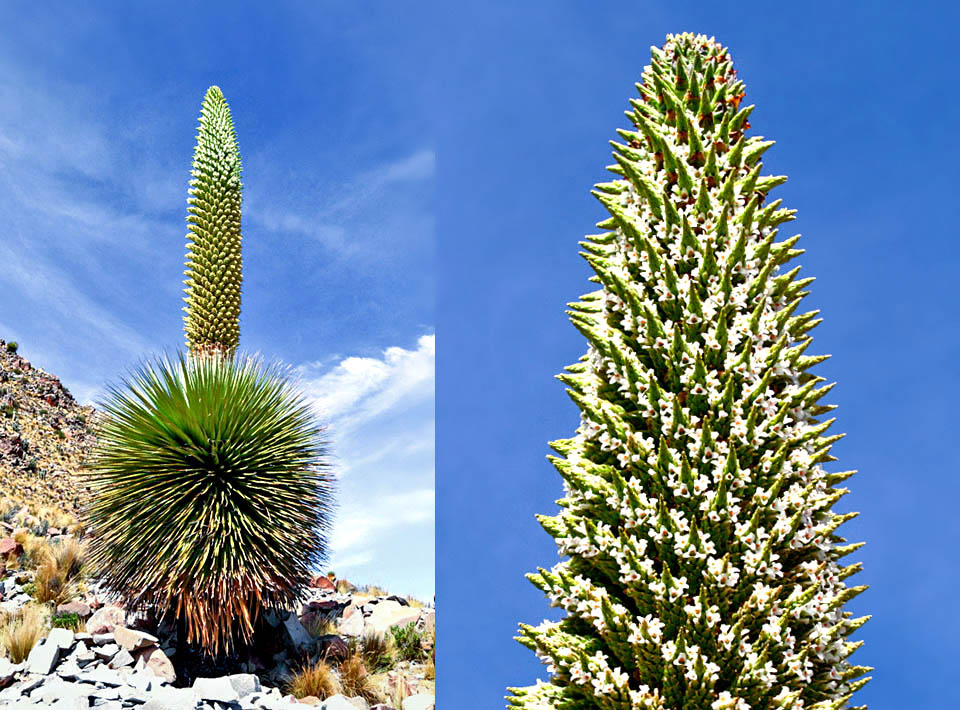
Puya raimondi, called Andes queen grows at 3200-4800 m of altitude. It’s the greatest monocarpic Bromeliacea reaching with reaches 10 m in height with the inflorescence © James Brunker
In some species has occurred also the return of the entomophily (i.e. Fosterella) and exist lineages with ornithophily including species pollinated by bees (i.e. Tillandsia multicaulis Steud.), by moths (i.e. Pitcairnia albiflos Herb., Pitcairnia unilateralis L. B. Sm., Tillandsia utriculata L.) and by bats (i.e. Billbergia horrida Regel, Encholirium spectabile Mart. ex Schult. & Schult.f., Guzmania fosteriana L.B.Sm., Pitcairnia albiflos Herb., Puya ferruginea (Ruiz & Pav.) L.B.Sm., Tillandsia heterophylla E.Morren, Vriesea jonghei (K.Koch) E.Morren, V. longiscapa Ule,
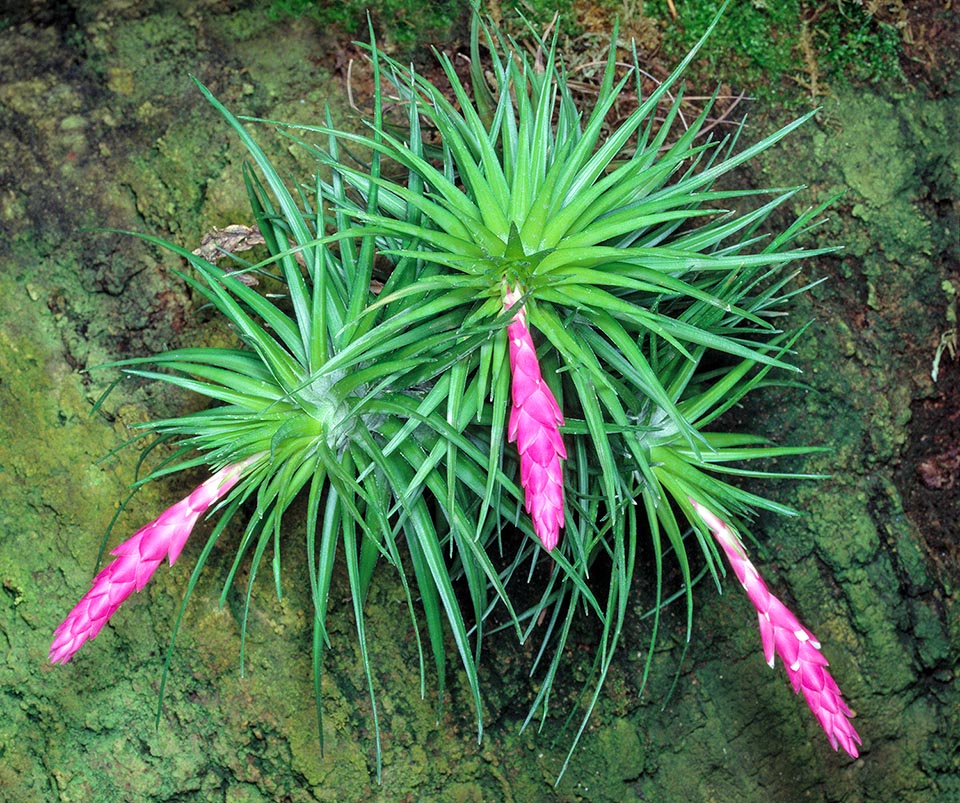
Conversely Tillandsia tenuifolia is one of the smallest species of the group. It also dies after blooming but other rosettes sprout on the sides forming in the years dense tufts © Giuseppe Mazza
Hummingbird-pollinated species have brightly colored flowers, generally orange-red, while bat-pollinated species have white corolla.
Particular characteristic of the family is the presence of septal nectaries (or septal glands), so called as placed between the septa of the single carpels, therefore inside the ovary. A study concerning Ananas ananassoides (Baker) L.B.Sm.highlighted that the septal nectary extends from the base of the ovary to the base of the style and is composed of three ducts formed by a secretory epithelium and by a nectariferous parenchyma rich of starch granules that are hydrolyzed in the nectar secretion phase.
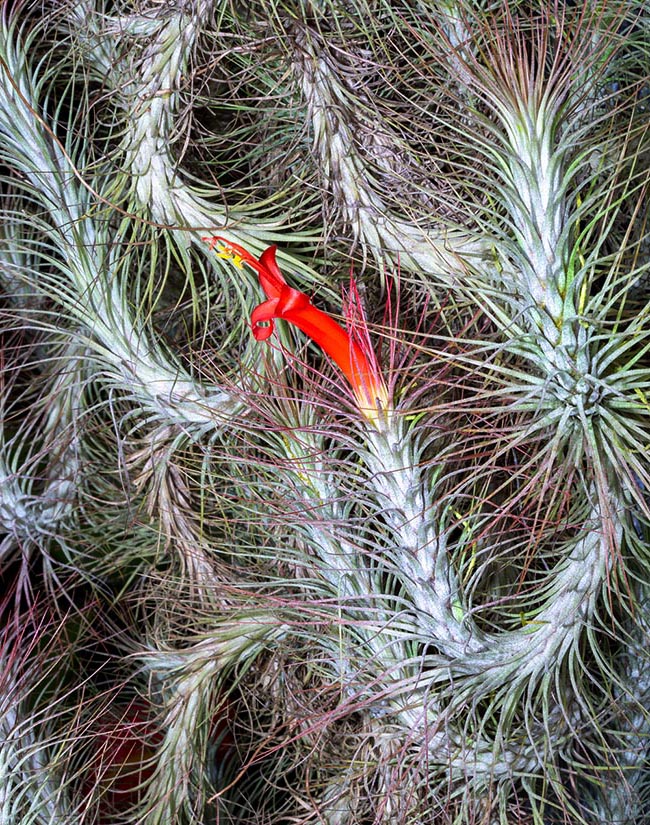
The rosette-like leaves can be at times needle-shaped, as in Tillandsia funckiana, rare South american species © Giuseppe Mazza
It has been noted that with the increase of the number of visits done by its usual pollinators, the hummingbirds, identified as Hylocharis chrysura (Shaw, 1812) and Thalurania glaucopis (Gmelin, 1788), the production of nectar increases in order to deal with the greater collection whilst the sugar concentration decreases.
The study about the composition of the sugars present in the nectar has shown that it is not linked to phylogenetic relations, but it is all about adaptations to the preferences of the pollinators.
As a matter of fact, plants pollinated by hummingbirds coming from different geographical regions have the nectar with the same sugar composition, this indicates an adaptive convergence that reflects the taste preferences and/or the physiological restrictions of the digestive system of these birds.
The inflorescences can be very big like those of Puya raimondii or of a few centimetres like those of some species of Brocchinia and Tillandsia.
Usually, the inflorescences, besides having bright colours, are long-lasting.
A major part of the species of the family has fleshy fruits (i.e. Nidularium, Billbergia, Aechmea), but some produce dry fruits (capsules), like in Tillandsia, Vrisea, Pitcairnia and Puya.
The dispersion of the fleshy fruits and of the seeds takes place by means of animals (usually vertebrates, but, in rare instances, by ants), because they nourish with the fruits or of the seeds.
The dispersion of the seeds with feathery appendages (i.e. Tillandsia usneoides L.) produced by dry fruits (capsules), takes place by means of the wind.
The family regroups essentially hermaphrodite species, but there can be dioecious species, individuals having male flowers and others with female ones (i.e. Hechtia schottii Baker) and species monoecious (i.e. Tillandsia achyrostachys E.Morren ex Baker), that is, individuals with male flowers (staminiferous) and female flowers (pistilliferous) on the same plant.
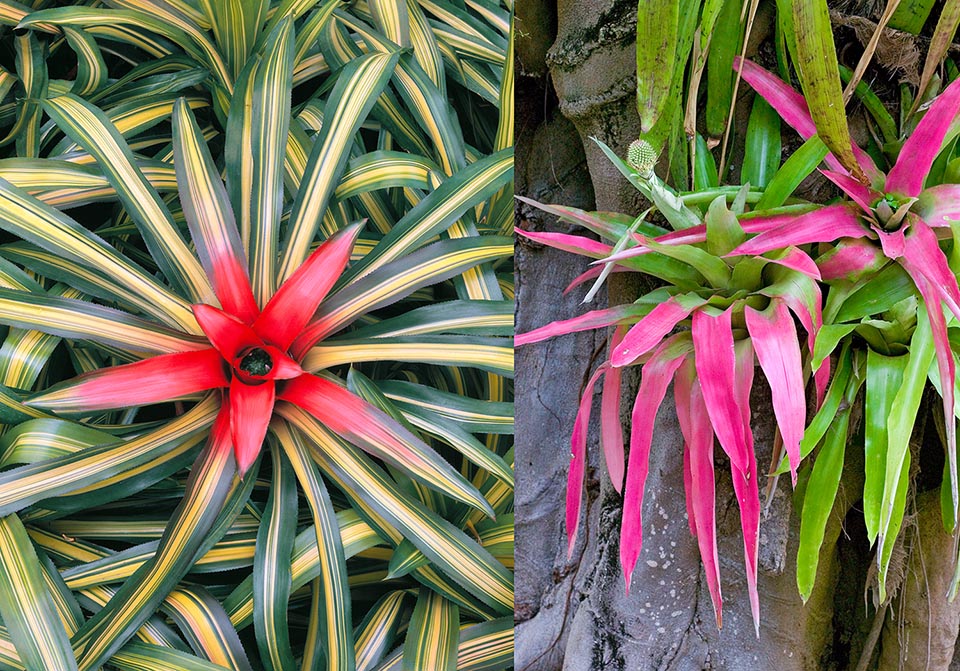
However usually the leaves are much wider and conspicuously coloured to attract the pronubes attention. Here Neoregelia carolinae var. tricolor and Aechmea pectinata © Giuseppe Mazza
In the family (excluding the genera Dyckia and Tillandsia), stand monocarpic species, which means that they bloom; produce seeds and die, usually after having formed at the base, between the leaves, new plants they feed till their independence, with the formation of roots.
The Bromeliaceae present species with morphological and ecological characteristics very different from each other and are very important and distinctive elements of the neotropical ecozone that includes South America, Caribbean Islands, Central America, and southern Florida. Inside this vast ecozone, the Brazilian Atlantic Rainforest (BAF) represents one of the centres of major diversity with 1.246 catalogued species, of which 1.067 endemic.
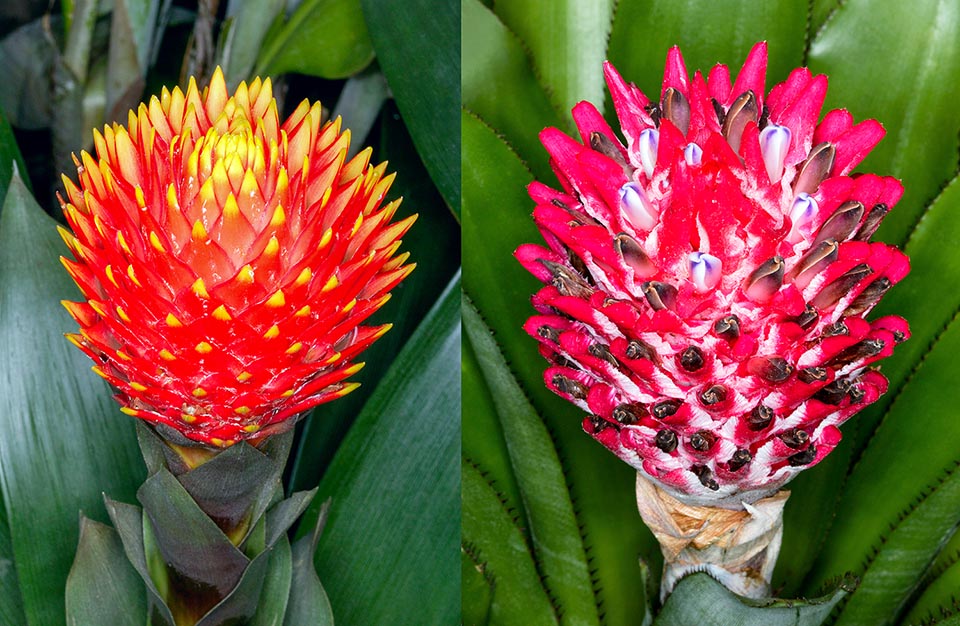
Also the inflorescences do everything to be noted. Here (left) the flaming pine shaped scape of Guzmania conifera and that, not less showy, of Quesnelia arvensis (right) © Giuseppe Mazza
The genera richest of species are Aechmea, Alcantarea, Bromelia, Dyckia, Encholirium, Pitcairnia, Tillandsia and Vriesea.
Unfortunately, this biome (BZAF) has been seriously destroyed and reduced nowadays to only 13% of its original area and this has also resulted in a serious loss for this species.
Totally, after the IUCN (International Union for Conservation of Nature) criteria, the family Bromeliaceae has 30 species in critical period (CR), 94 endangered (EN), 87 vulnerable (VU), and 31 near-threatened (NT).
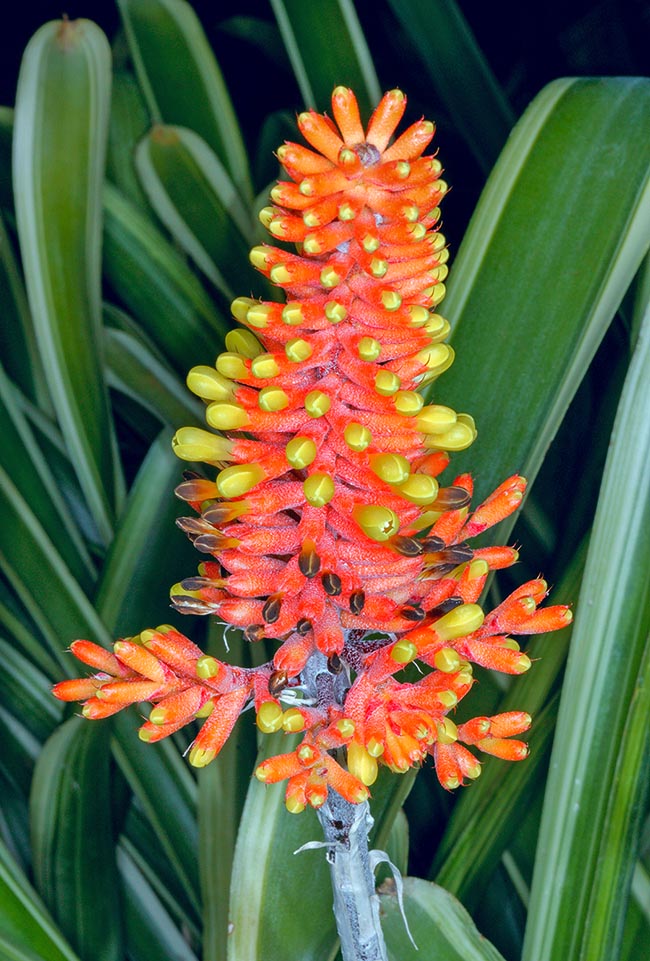
Aechnea caudata, native to Brazil, creates an even 1 m tall inflorescence with yellow flowers on red orange bracts © Giuseppe Mazza
Nidularium is the highly vulnerable genus and at risk of extinction. The giant of Peru and Bolivia Puya raimondii, is at risk of extinction too.
The conservation of the genetic diversity, therefore, is a priority objective and is done with specific studies through molecular markers of the populations in order to have information concerning the risk of extinction of the species and to be able to carry out effective conservation strategies. The loss of biological diversity has negative impacts on ecosystems and, as consequence, also on man. Many species form micro ecosystems where the stored water and the nutrients render life possible to other organisms, whether animal or vegetal.
The presence of the Bromeliaceae in a great diversity of habitats going from the sandy dune ot the desert coats and from the humid savannahs to the mountain tropical pluvial forests, has been possible thanks to particular physiological characteristics that have permitted to conquer habitats very restrictive both from the point of view of water supply and of nutrition.
Basic characteristic is the presence of the CAM (Crassulacean Acid Metabolism), that is a process of fixation of the carbon dioxide (CO2) that takes place mainly during the night, avoiding the excessive loss of water that would occur during the day through the stomatal apertures. On the other hand, in the family stand also plants with metabolism C3, so called because the first stable molecule forming from the photosynthetic process is the phosphoglyceric acid with 3 carbon atoms.
These plants, that are photosynthetically active by day, therefore losing water through the stomata, present however, morphological and anatomical modifications that allow them to be anyway successful in the arid environments.
Among the peculiarities we point out the presence of succulent leaves, with hydric accumulation tissue, peltate foliar hairs, highly specialized in the rapid and intermittent assumption of water, present in the epiphytic species of the genera Tillandsia L. and Vriesea Lindl. In these two genera the root system does not assume water but this is absorbed by the richly haired leaves.
Due to the absence of certain fossils, using the molecular clock, it is thought that the Bromeliaceae got their origin about 30,9 million years ago.
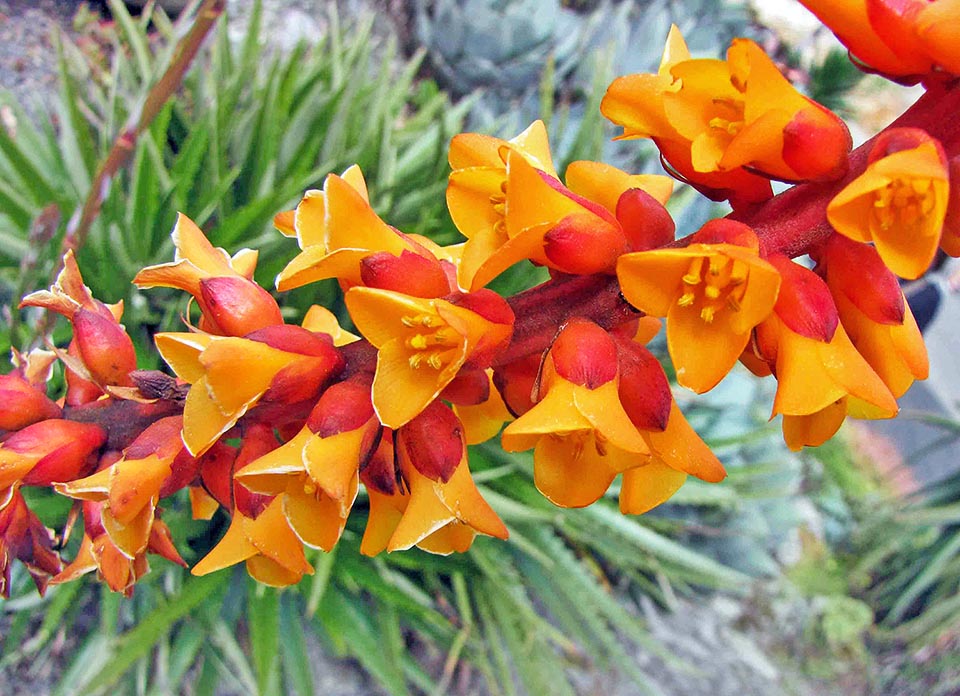
Of the same colour are the Dyckia frigida, up to 60 cm long inflorescences. This species, native to Brazil, has thorny rosettes of a nice bright green colour © 阿橋
The modern lineages began to diverge from each other about 19 million years ago and invaded the most arid areas of Central and South America starting 15 million years ago, coinciding with an adaptive radiation made possible by the epiphytism, the CAM photosynthesis, the leaves able to collect water and the various modifications of the foliar anatomy with the formation of trichomes and the accelerated diversification at the level of the genera. These upheavals occurred after the uplift of the northern Andes and the presence of Amazonia in its present place.
The epiphytism can have accelerated the processes of speciation by increasing the capacity to colonize the Andes all along their length thanks to their capacity of entering the rainforests often separated by more arid valleys.
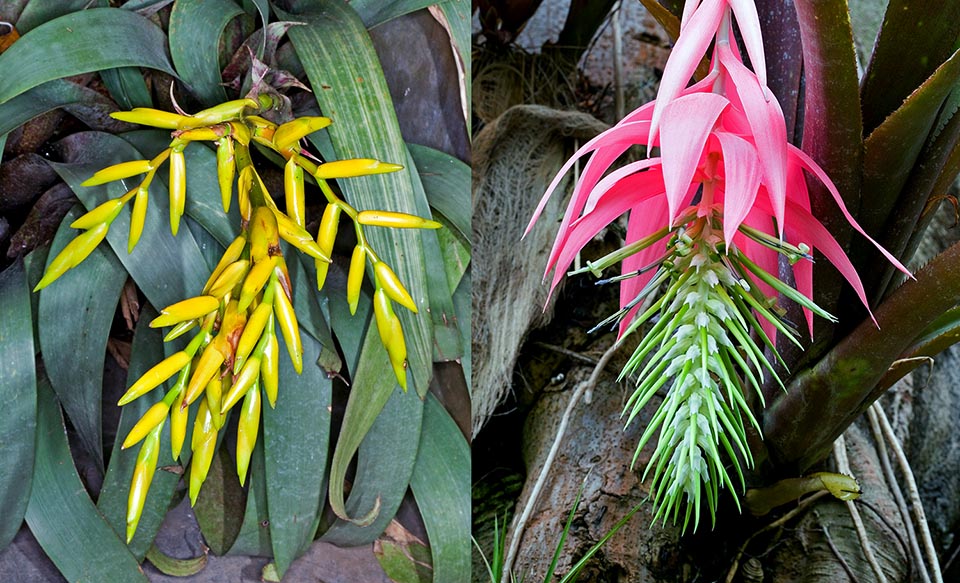
Left, Vriesea saundersii. From the twisted leaves, rosette arranged, get out inflorescences with flat ears, usually yellow. Right, the monocarpic Bilbergia rosea, one of the biggest species of the family, with long, cylindrically arranged leaves, and a drooping panicle-like inflorescence. Luminous pink bracts and unusual greenish flowers © Giuseppe Mazza
The presence of Pitcairnia feliciana in Africa can be dated to about 10 million years ago, so their distribution cannot be due to the continental drift, as the Americas have parted from Africa long before, but probably it is matter of a long-distance dispersion by means of seeds carried by migratory birds. In fact, the African species has flowers fairly similar to those of many American species, pollinated by hummingbirds, that is typically of red-orange colour, not perfumed and with abundant production of nectar.
The Bromeliaceae were utilized, in the past, by the Aztecs, by the Mayas and by the Incas as food, as medicinals and as ornaments for their sacred ceremonies.
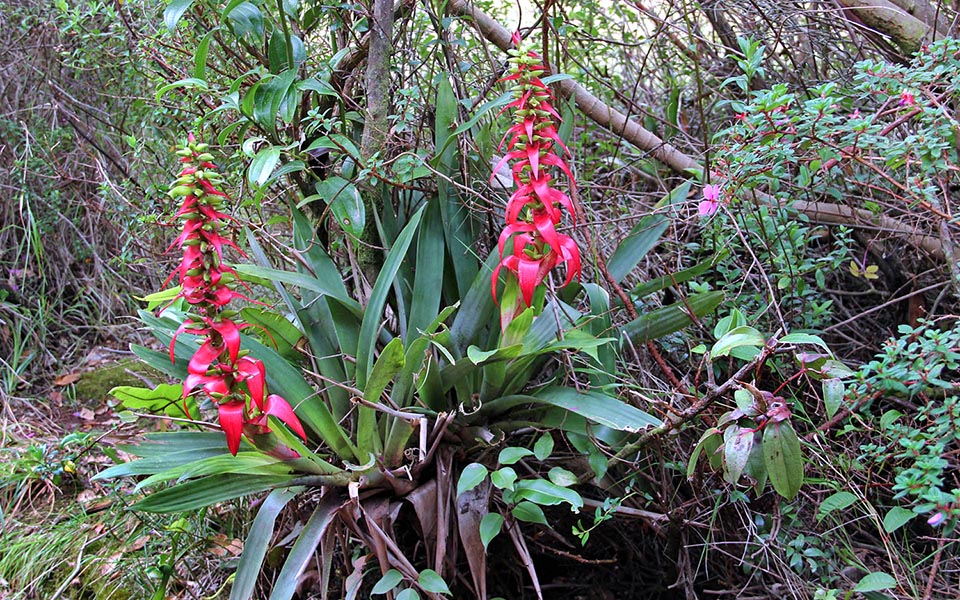
Werauhia ororiensis lives in Costa Rica rainforests between 1900 and 3300 m. The elegant erect inflorescence, not ramified, has greenish flowers and pinkish red bracts © Laszlo Bolgar
In Mexico, in the State of Chiapas, still now some species of Tillandsia are utilized as ornamental elements in the religious ceremonies (Tillandsia imperialis E.Morren ex Roezl); whilst T. ionantha Planch. is used in the construction of cribs and of Christmas decorations and T. usneoides (L.) L. (horsehair tillandsia) is employed as packing material.
Various species (i.e. Hechtia glomerata Zucc.) are utilized as fodder for cows and goats because they furnish food and water, in very arid locations peculiar to the areas with xerophilous shrubs.
In Europe, the family has been very known and appreciated thanks to its edible product, the famous pineapple.
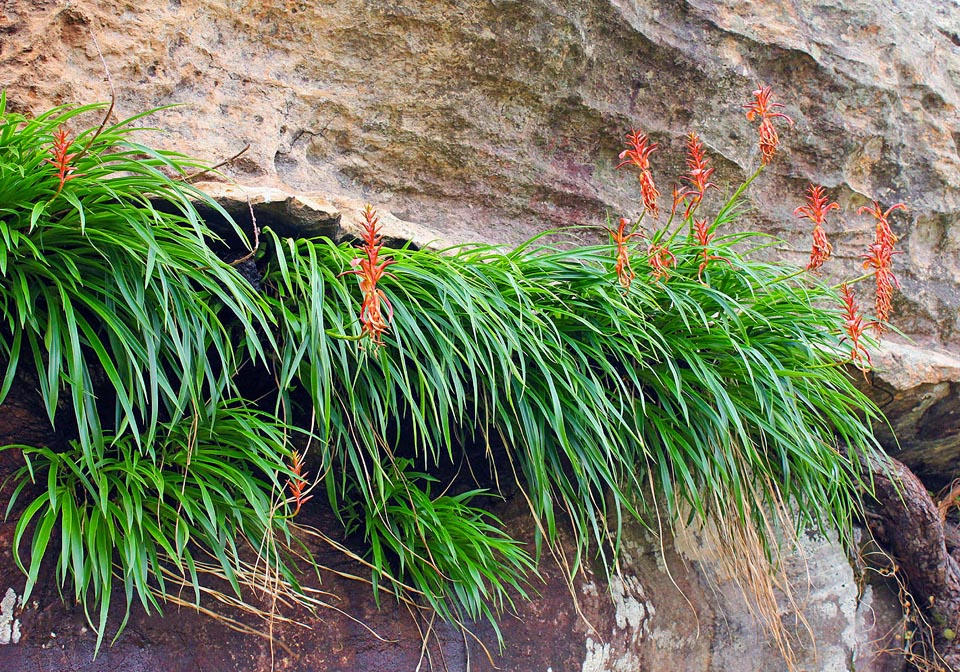
Pitcairnia feliciana is the only African species of the family. Grows in Guinea, with bright orange red flowers, on the sandstone outcrops of the Fouta Djallon highlands © Rainer Wendt
The plant (Ananas comosus (L.) Merr.) has thick and fibrous basal leaves and forms an inflorescence composed by sessile, closely together, flowers with the axis prolonging and carrying a crown of foliaceous bracts. The fruit is a fleshy berry that, together with the axis (core), and with the floral bracts, forms the edible part, called syncarp, as formed by several flowers.
Locally, natives also consume fruits of other autochthonous species (i.e. Bromelia palmeri Mez). In Mexico and in Central America some species like Aechmea magdalenae (André) André ex Baker are source of high quality fibres, strong and shiny, the famous pita for producing items embroidered on leather obtained with a technique known as piteado.
The fleshy fruits of some species as those of Bromelia karatas L. are utilized to prepare refreshing drinks. The thorny rosettes of Bromelia pinguin L., are utilized for fences.
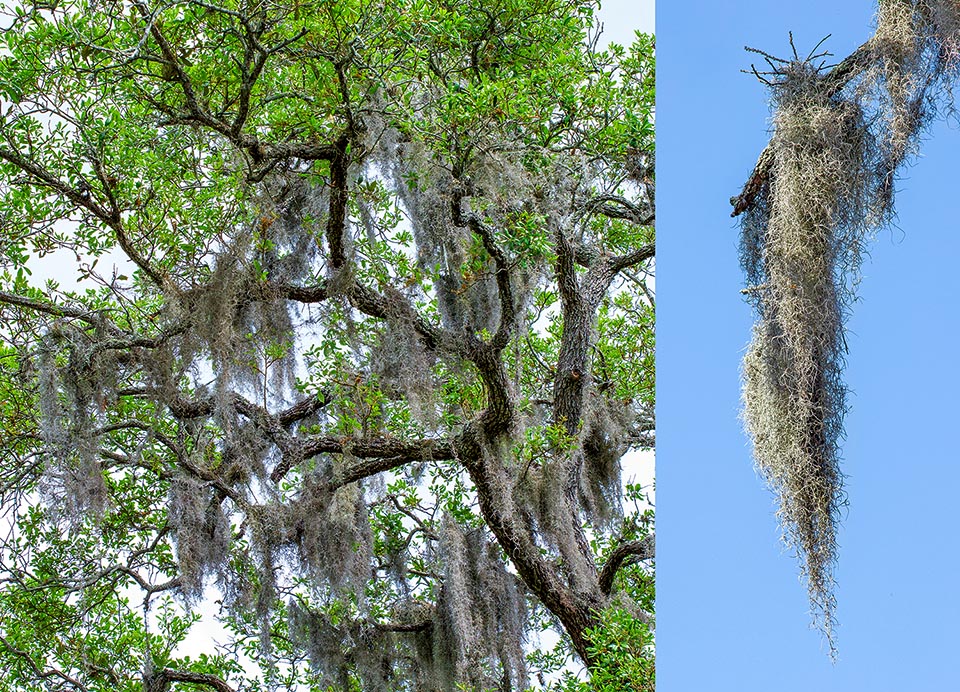
Tillandsia usneoides is an epiphyte with dry and tiny seeds it entrusts to the wind. It grows in warm and humid climates, from South-East USA to Arhentina and Chile © Giuseppe Mazza
Many species of the family have been employed for centuries in the popular medicine of the American natives. Latest researches are confirming the beneficial effects of the species they utilize, like, for instance, those causing the improvement of the digestive and respiratory functions. The extracts of some species of Bromelia are reported and utilized as anti-inflammatory, anticoagulant, antitumoral, and antiedematous (they prevent the formation of edemas) agents.
The ancient Aztecs used the fruit of Ananas comosus to favour the cooking of the meat. It has been proven, in fact, that the fruits of this species present the proteolytic enzyme bromelain, whilst in the fruits of Bromelia pinguin L. (= Bromelia fastuosa Lindl.) is present the fastuosain enzyme.
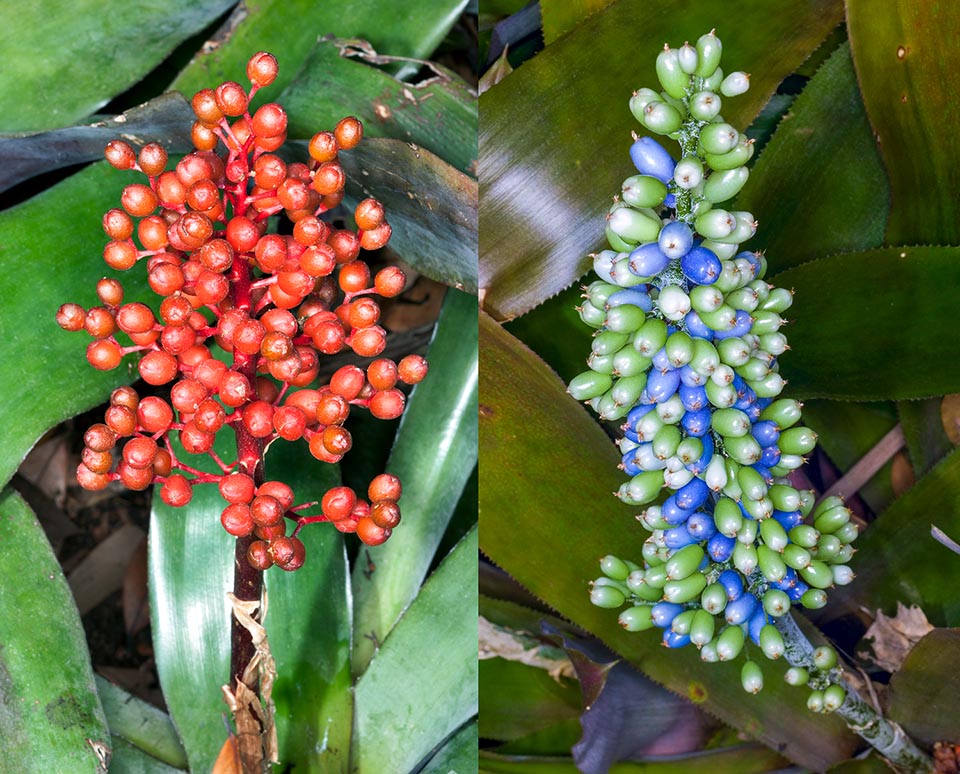
Many Bromeliaceae produce also bright fleshy fruits, such as Aechmea fulgens, left, and Aechmea mexicana, to attract the birds who disperse their seeds © Giuseppe Mazza
These enzymes, able to degrade the proteins in amino acids, have been noted to induce apoptosis, that is the cell death of the carcinoma of the human epidermis and of the cells of the melanome.
As many species presenting medicinal activity are at risk of extinction or are vulnerable due to human exploitation, they are proceeding to the use of alternative methods that can allow their use.The cultivation in vitro of vegetal tissues represents an ecological choice to obtain cuttings under controlled conditions. This system of cultivation allows to obtain various compounds of pharmacological interest without compromising the natural levels of the populations. Recent studies have revealed that Nidularium procerum Lindm has analgesic, anti-inflammatory, anti allergic and anti tumoural properties on the adreno-cortical carcinoma, a rare malignant tumour, that takes form in the cortical portion of the surrenal gland located in the upper pole of the kidney.
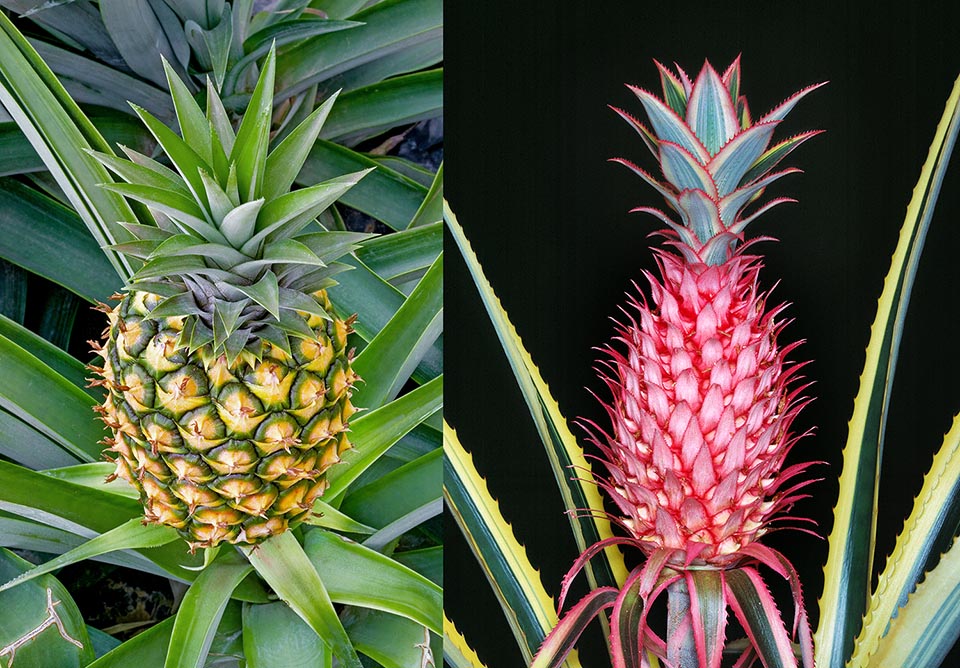
With its large, compound fruit, the Ananas comosus is a well- known food plant, whilst the Ananas bracteatus ‘Tricolor’ is at times cultivated as an ornamental curiosity © Giuseppe Mazza
Several species of the family hold great potentialities for becoming important sources of chemical and pharmaceutical products.
During the last decades some species of Tillandsia like T. usneoides have been employed in geographical areas of the whole world for the biomonitoring of the atmospheric metals thanks to their capacity to store and hold the pollutants. In fact, they are sensitive and selective plants for some metals, able to quickly respond to even small changes in the atmospheric composition, this makes them useful for comparing sites or for biomonitoring events in a short time. The species Tillandsia brachycaulos Schltdl. and T. stricta Sol. ex Ker Gawl have also been utilized even for the monitoring the nuclides being in condition to store Caesium (Cs) and Strontium (Sr).
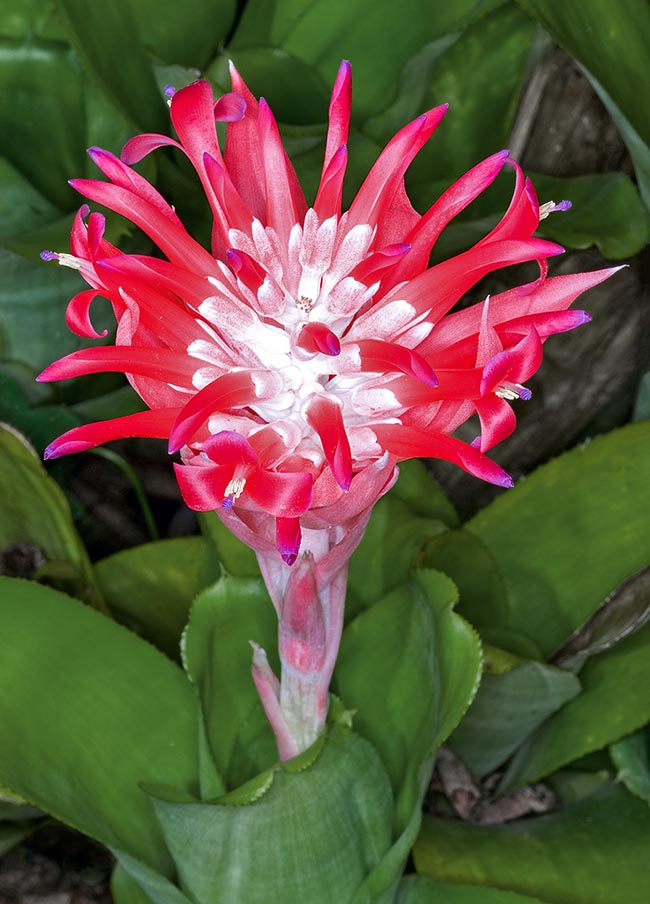
Billbergia pyramidalis is often present in the tropical or warm temperate climate gardens and in the home © Giuseppe Mazza
However, this family is known for its many species, known all over the world as very ornamental plants.
The cultivation is fairly simple as these plants do not require particular care.
In the tropical and subtropical climates they can be cultivated in open air, in loam mixed with sand, as these are epiphytic plants, having the foresight to guarantee them a good light exposure, but not to expose them to direct sunlight.
The species suitable for open air cultivation belong to the genera: Aechmea, Billbergia, Ananas, Neoreglia and Tillandsia.
They can be cultivated also in pots, as indoor plants, in a way to be sheltered from cold in the temperate cool climates. The species with thick leaves, (Aechmea), require dry environments, such as the window sills, whilst those with thin leaves, (Tillandsia), prefer the humid sites such as the kitchen or the bathroom.
In winter, waterings must be reduced (every 20-30 days), whilst in spring and summer periods they can be watered even daily, but paying careful attention to avoid water stagnation that may cause rottennesses. In summer, it is good to fill up the central pool of the rosette of leaves with water.
For a vigorous growth an a rich blooming, in particular for the plants cultivated in pots, it is good to fertilize them with a ternary manure (nitrogen, phosphorus and potassium) with a light prevalence of the nitrogen and the phosphorus, and with microelements, if necessary.
In spring, if there are present lateral buds and have reached a height of one third of the mother plant, it is possible to take them off thus to reinforce the mother plant and in the mean time to obtain new plants to pot.
Almost all cultivated plants as ornamental can reproduce also by seeds utilizing suitable germinators.
Among the parasites that may attack the cultivated plants, we cite the red spider, the cochineal, the lice and the lites. In order to defeat them it is suggested to employ antiparasitics of biological origin.
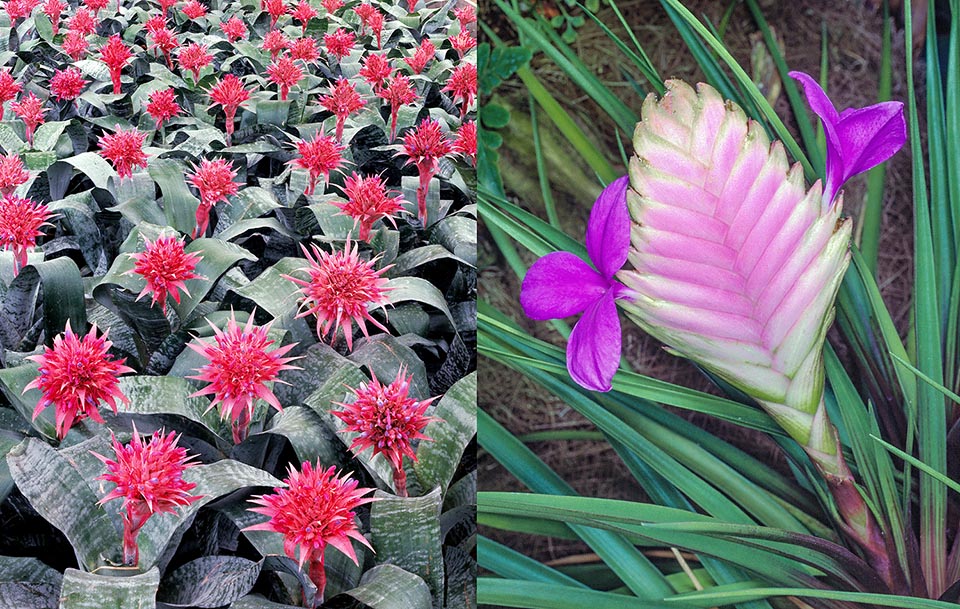
Aechmea fasciata and Tillandsia cyanea. Cultivated as ornamental plants or for feeding, the Bromeliaceae have an annual revenue of several billion © Giuseppe Mazza
Subfamilies and genera. In brackets the number of the species presently recognized (2021).
Brocchinioideae: Brocchinia (20) – Bromelioideae: Acanthostachys (3), Aechmea (244), Ananas (3), Androlepis (3), Araeococcus (8), Billbergia (63), Bromelia (70), Canistropsis (11), Cryptanthus (60), Deinacanthon (1), Disteganthus (4), Edmundoa (3), Eduandrea (1), Fascicularia (1), Fernseea (2), Forzzaea (7), Greigia (36), Hohenbergia (50), Hohenbergiopsis (1), Hoplocryptanthus (9), Karawata (7), Lapanthus (2), Lymania (10), Neoglaziovia (3), Neoregelia (123), Nidularium (47), Ochagavia (4), Orthophytum (67), Portea (8), Pseudaechmea (1), Pseudaraeococcus (6), Quesnelia (23), Rokautskyia (14), Ronnbergia (22), Sincoraea (11), Ursulaea (2), Wittmackia (44), Wittrockia (7), x Hohenmea (1) – Hechtioideae: Hechtia (84) – Lindmanioideae: Connellia (6), Lindmania (39) – Navioideae: Brewcaria (6), Cottendorfia (1), Navia (94), Sequencia (1), Steyerbromelia (9) – Pitcairnioideae: Deuterocohnia (16), Dyckia (176), Encholirium (37), Fosterella (34), Pitcairnia (410) – Puyoideae: Puya (227) – Tillandsioideae: Alcantarea (41), Barfussia (3), Catopsis (18), Cipuropsis (3), Glomeropitcairnia (2), Goudaea (2), Gregbrownia (4), Guzmania (216), Jagrantia (1), Josemania (5), Lemeltonia (7), Lutheria (4), Mezobromelia (5), Pseudalcantarea (3), Racinaea (82), Stigmatodon (20), Tillandsia (755), Vriesea (231), Wallisia (5), Waltillia (1), Werauhia (94), x Guzlandsia (1), Zizkaea (1).
→ To appreciate the biodiversity within the family BROMELIACEAE family please click here.
